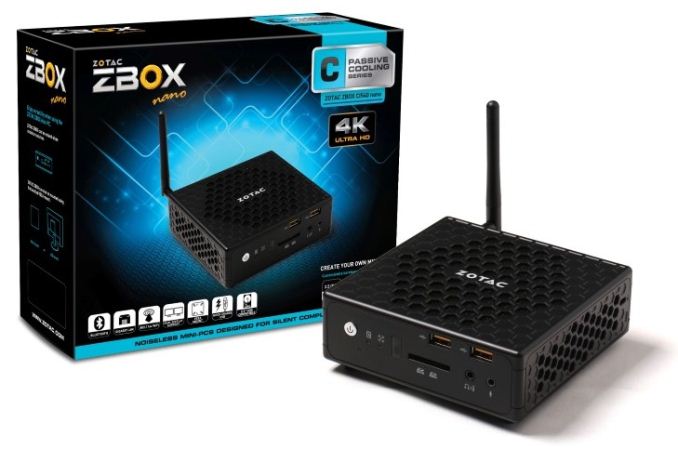Zotac ZBOX CI540 nano Review: A Fanless Haswell-Y mini-PC
by Ganesh T S on October 31, 2014 11:00 AM ESTFinal Words
Zotac's ZBOX CI540 nano provided us with the first opportunity to evaluate the performance of a Y-series CPU from Intel. The Core i5-4210Y is surprisingly powerful. Passively cooled systems are either very costly (particularly if they integrate powerful CPUs) or downright abysmal in performance (when they integrate the low-end / low-power CPUs such as the older Atoms). Zotac's offering with the ZBOX CI540 nano aims to strike a balance. $335 for a barebones configuration is quite reasonable for this type of system.
One of the aspects that we were worried about prior to evaluation was thermal throttling. Fortunately for Zotac, the Core i5-4210Y seems to keep the scenario design power (SDP) in mind while managing the internal clocks. Intel's intent with the Y-series is such that CPU performance needs to be talked about in terms of power consumption rather than absolute clocks. Outside the benchmarking circus, day-to-day workloads for the average mini-PC user actually fall rather nicely into the SDP aspect.
Pretty much the only downside of the unit is the unreasonably high idle power. Perhaps Zotac could look into some default BIOS optimizations to resolve that aspect. Other than that, the platform ticks everything needed in the mini-PC market - plenty of USB ports, quick charging capabilities, 802.11ac WLAN with Bluetooth integrated, a SD card reader and even a Display Port output along with the traditional HDMI. All these are packaged along with the Core i5-4210Y - one of the most powerful CPUs in the 11.5W TDP range. With the ZBOX CI540 nano, Zotac has managed to deliver the right balance of price and performance in the fanless mini-PC market.











48 Comments
View All Comments
CrazyElf - Friday, October 31, 2014 - link
To be honest, I'm not too crazy about this "super small" mentality. It seems like people are going super small as an end into itself more than anything else.The problem is that smaller means that more heat has to be put through a small space, as this example here shows. A slightly larger design here I think would have been an advantage.
jabber - Friday, October 31, 2014 - link
Yes it seems you can go from a m-atx box to something minute. Doesn't have to be 'as small as you can make it'. Something the size of say a PS2 or a little smaller would be fine.Calista - Saturday, November 1, 2014 - link
Fully agree, even something in the 20x20x20 cm size doesn't occupy much more size then say a NUC once we include space for cables for power, monitor, keyboard and mouse.Alexvrb - Sunday, November 2, 2014 - link
Agreed. I can't imagine going smaller than a baby ITX box, if for no other reason than it's easier to upgrade or modify. :Djosue16 - Friday, October 31, 2014 - link
Will you guys add LAN latency tests? That is if it can be reliably measured. Also, gigabit Ethernet tests would be nice too.knightspawn1138 - Friday, October 31, 2014 - link
I like the thermal pictures. It looks like a space age furnace or reactor. Or like it's a box of lava. Not sure if I want to hang this on the VESA mount on the back of a $1500 TV set.bobbozzo - Friday, October 31, 2014 - link
Can SSDs tolerate 75C?Shadowmaster625 - Friday, October 31, 2014 - link
$500 for a notebook with no screen and no battery/UPS. What a great deal! Sign me up for 3. NOTzodiacfml - Saturday, November 1, 2014 - link
i agree. the notebook i'm using now is only 250 USD with probably the same performance of this low voltage cpu.kmmatney - Friday, October 31, 2014 - link
I've never had an "HTPC" (I have a windows home server and a WD live player) so I'm not an expert on this, but couldn't a laptop perform the same function? It's cheaper and a lot more capable. $350 gets you a core i5 laptop with HD4400 graphics not to mention a keyboard, screen, and OS. Maybe it takes a little more space, but having the screen would make it easier to setup.